Vintage clothing – some advice for men.
(1) Be persistent. As previously noted, authentic swing-era vintage clothing in good condition, especially in the larger sizes, can be hard to find. But don’t let that stop you – the hunt is part of the fun!
(2) If you got it, wear it. Over time, I’ve managed to acquire some really nice 1920’s/30’s/40’s/early 1950’s vintage clothing items: ties, shoes, suits, jackets, pants, overcoats, gloves, etc… I first started wearing vintage clothing when I would go out swing dancing. At most swing dance events I wear vintage clothing, primarily the 1930’s or 40’s vintage look. My wife Mary also likes to wear vintage clothing, and we often get compliments on our clothing choices.
But I was initially hesitant to wear vintage clothes as a part of my “regular” clothing choices. But now I feel very comfortable and confident wearing vintage clothes on a regular basis.
My advice is if you got it, wear it, but within reason, and of course, use common sense. For example, I keep it “toned down” when I wear vintage clothes to church (but even “toned down” I’m one of the better dressed gents at church). For example, I would personally not wear two tone spectator shoes to church. And while I have worn vintage clothes to many employer sponsored and work related social functions, I was pretty much polo shirt and khaki pants for my regular work hours.
(3) Esquire Magazine. I use Esquire Magazine from the 1930’s and 40’s as a source of inspiration and information for my personal styling choices. A couple of notes about Esquire Magazine of the 1930’s and 40’s.
Equire Magazine debuted in autumn of 1933 and was very successful from the start. It was really the first regularly published magazine dedicated to men’s fashion, with a combination of men’s clothing illustrations and advertising and well written articles on not just men’s fashion but also sports, humor and sometimes world politics and events.
For today’s men’s vintage clothes enthusiasts, the color illustrations and accompanying “banter” to those illustrations is without equal. The main artists for those Esquire illustrations were Laurence Fellows, Leslie Saalburg and Robert Goodman.
(4) Know your sizes! If buying vintage clothes from a store or online, you need to know your sizes. Pick some of your clothing that fits you well. Then take the measurements for your jacket, which would include shoulder-to-shoulder, sleeve, chest and length. And for trousers you’ll need to know your waist, rise and the inside leg measurements. For dress shirts, you’ll need collar, chest, sleeve and length. Of course in a vintage store, you want to try on any clothes you are considering buying. And hold the clothes up to a strong light or a well lit window, a good way to see if there are any moth holes.
(5) Keep “fit” in mind – and find a good alterations shop! For a lot of items you buy at a vintage store or on-line, you’ll need the services of a good alterations shop. Nothing wrong with getting an item altered a bit, i.e. taken in, let out, etc… But resist the temptation to wear vintage clothes that are just too big or too tight. Keep “fit” in mind!
(6) A note of caution about vintage clothes and swing dancing. Always consider the rarity and condition of your vintage clothes and how much wear and tear those vintage clothes will endure if you wear them swing dancing. For example, if you are going to a summer street dance or some other type of outdoor summer dance (where you will sweat a lot!), you probably shouldn’t wear your good vintage clothes. Stick with the vintage reproduction type clothes for those events. And of course, you wouldn’t want to wear your hard-to-find vintage shoes on concrete or some other similar dance floor surface.
 Now, on to the actual clothing!
Now, on to the actual clothing!
Jackets. For jackets I prefer a vintage jacket or sport coat: a solid color, houndstooth, herringbone or checked type pattern, with a wide, swing-era style lapel. Generally, you want the width of your tie to be in somewhat the same proportion as your jacket lapel.
herringbone or checked type pattern, with a wide, swing-era style lapel. Generally, you want the width of your tie to be in somewhat the same proportion as your jacket lapel.
Suits. For suits, I prefer a 1930’s or 40’s vintage suit, either 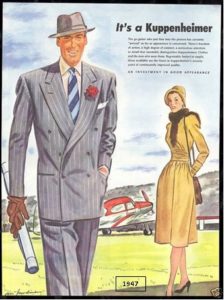 a doubled breasted or single breasted suit, with the peak and wide lapel, a very classy look! Suits can be hard to fine, especially in the larger sizes. And note you’ll probably need the services of a good tailor to fit almost any suit you buy second hand.
a doubled breasted or single breasted suit, with the peak and wide lapel, a very classy look! Suits can be hard to fine, especially in the larger sizes. And note you’ll probably need the services of a good tailor to fit almost any suit you buy second hand.
Pinstripe suits (generally grey/dark blue/brown) were worn a lot in the swing-era, but those type swing-era vintage suits can be hard to find (especially in the bigger sizes, as previously noted).
If you do wear a reproduction “swing-era style” suit or other reproduction vintage clothing, stick with the traditional colors, and not any “over the top” colors/color combinations. Keep in mind your goal should be to dress and look vintage, and not “cartoonish”.
And for summer events, I like the lighter color vintage look. And summer is the time to break out your two-tone spectator shoes.
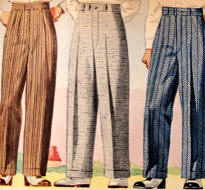 Pants. I most often wear vintage pants from the 1930’s, 40’s/early 50’s; once again, they can be hard to find in the larger sizes. Keep in mind that pants in the swing-era had a much fuller and generous cut than pants worn today.
Pants. I most often wear vintage pants from the 1930’s, 40’s/early 50’s; once again, they can be hard to find in the larger sizes. Keep in mind that pants in the swing-era had a much fuller and generous cut than pants worn today.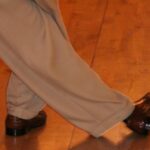
I usually go for a dress pant in a contrasting, but complimentary color to the jacket I wear. Note the pants should be cuffed, and not straight. If you get pants cuffed, ask for a 1.5-2.0″ cuff, the increased weight will help keep the pant leg straighter.
Remember to stick to the basic, classic colors – the goal is to look vintage/classy/stylish, and not “cartoonish”.
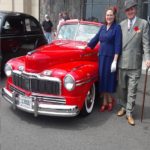 Be careful of heavy wool pants. I find that a lot of the heavy wool blend pants retain a lot of heat and sweat when dancing, although they do hold their shape. If these heavy wool blend pants get really wet, they get even more heavy. Go for the wool pants with a light feel.
Be careful of heavy wool pants. I find that a lot of the heavy wool blend pants retain a lot of heat and sweat when dancing, although they do hold their shape. If these heavy wool blend pants get really wet, they get even more heavy. Go for the wool pants with a light feel.
Khaki or other casual type pants would seem to be a good choice for swing dancing but they really aren’t, and they generally don’t look 1930’s/40’s vintage. I find these type pants soak up sweat and rapidly lose their shape. And sweat pants, “gym” pants, cargo type pants or pajama type pants are really not appropriate for a social dance event (and really not appropriate for most social occasions).
Some pants made from cotton/linen blends are nice for outdoor swing dance events. Ensure the fabric has a “light” feel to it and that it will hold its shape.
Ties. Ties have an interesting history (but I digress!). Vintage ties are one of 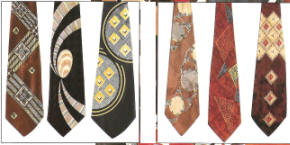 the easier vintage items to find (both on-line and at vintage stores), are generally affordable, and really give your clothing some “pop” and color.
the easier vintage items to find (both on-line and at vintage stores), are generally affordable, and really give your clothing some “pop” and color.
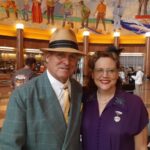 I like to wear vintage swing-era 1930’s, 1940’s/early 1950’s ties. Many of the mid 1940’s to early 50’s ties have a “bold”, “geometric” or “art deco” type pattern and a bright color. There were a multitude of different colors used for swing-era ties. Ties from the swing-era were generally about 44-52″ in length, shorter than ties worn
I like to wear vintage swing-era 1930’s, 1940’s/early 1950’s ties. Many of the mid 1940’s to early 50’s ties have a “bold”, “geometric” or “art deco” type pattern and a bright color. There were a multitude of different colors used for swing-era ties. Ties from the swing-era were generally about 44-52″ in length, shorter than ties worn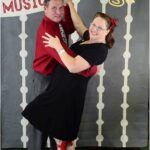 today and did not cover the belt buckle area (which is opposite of the general rule for today). Ties with a “geometric” or “art deco” type pattern were generally more prevalent in the mid 1940’s (generally post WW II) to about the early 50’s. Striped ties were more common in the 1930’s to about the end of WW II.
today and did not cover the belt buckle area (which is opposite of the general rule for today). Ties with a “geometric” or “art deco” type pattern were generally more prevalent in the mid 1940’s (generally post WW II) to about the early 50’s. Striped ties were more common in the 1930’s to about the end of WW II.
Dress shirts. For a dress shirt, I often wear a muted solid color, or small patterned or pinstriped dress shirt, almost always with long sleeves, sometimes with French cuffs, with a point or straight collar; sometimes I’ll wear a dress shirt with a button down or tab collar. I’m not a fan of spread collars for dress shirts, for a lot of men it (makes your neck look big. The 1930’s/40’s spear point collar shirt of the swing era is hard to find, but there are reproductions available on-line.
Beware of dress shirts with “too bright or a “neon” color, or a busy 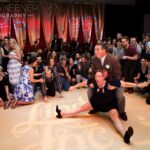 pattern (s); they can be difficult to “match up” and may “over power” your ensemble. A dress shirt with French cuffs gives a nice, classy look, although even those shirts new are a bit hard to find and normally cost more. And of course you’ll need cuff links for a French cuff shirt.
pattern (s); they can be difficult to “match up” and may “over power” your ensemble. A dress shirt with French cuffs gives a nice, classy look, although even those shirts new are a bit hard to find and normally cost more. And of course you’ll need cuff links for a French cuff shirt.
For French cuff shirts, go with vintage and classic looking cuff links (see info below). A tip from my wife: when swing dancing, wear cuff links with a rounded edge and not a square edge; the square edge type cuff link may scratch your dance partner.
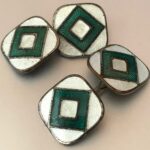
Cuff links. Vintage cuff links are relatively affordable and are somewhat easy to find, either at vintage stores or on-line. I prefer the art deco, enameled, double faced cuff links from the 1920’s and 30’s (which are harder to find and generally more expensive); avoid cuff links newer than the early 1950’s.
Shoes. My first preference is to wear vintage swing-era shoes from the 30’s/40’s/50’s. Men’s shoe styles didn’t change that much from ab out the late 1920’s to about the mid-to-late 1950’s. Along with the tie, vintage shoes can really give your outfit that vintage look. Two tone spectators (black and white, brown and white) are classic swing-era, along with spectators with a ventilated and/or mesh look.
out the late 1920’s to about the mid-to-late 1950’s. Along with the tie, vintage shoes can really give your outfit that vintage look. Two tone spectators (black and white, brown and white) are classic swing-era, along with spectators with a ventilated and/or mesh look.
If you buy vintage shoes on-line, make sure you check the measurements, and examine the pictures closely for condition. As with clothing, if you wear reproduction “swing-era style” shoes, stick to the basic, classic colors (brown/white, black/white) – as previously noted the goal is to look vintage/classy/stylish, and not “cartoonish”.
Dress Socks. Over the calf socks dress socks is the way to go for a dapper gent. As the name implies, over the calf socks fit over your calf, which keeps the socks from sliding down. Stick to the classic men’s wear colors and patterns; don’t go for the wild colors, like neon, and over the top patterns. And it goes without saying: don’t wear athletic socks with dress shoes.
Knitwear. Knitting is the process of turning thread and/or yarn into clothes; knitting has of course been around since ancient times. Machines for knitting been appearing around the 1850’s, and constant improvements were made in the machinery. By the 1920’s knitwear such as sweaters, cardigans, pullovers, sweater vests, etc.. were available in a great variety of colors, patterns, long and short sleeved.
Truly vintage knitwear can be hard to find. Keep an eye out for quality reproductions from establishments such as Simon James Cathcart, Revival Vintage UK, to name just a couple. The Ralph Lauren brand from the1980’s and 90’s also has some very good, vintage inspired knitwear.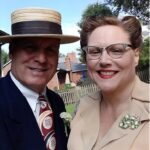
Hats. A classic style 1930s/40s hat gives one a nice vintage look. Depending on the season and what clothing I’m wearing I like a nice Fedora, Homburg or Panama hat; and for a 1920’s Charleston look, try a Boater hat. As with clothes, vintage hats from the swing-era can be expensive and hard to find. Get up to speed on hat etiquette: in general, don’t wear your hat indoors!
Accessories. While you don’t want to go overboard, accessories can really add that something extra to your style. A pocket square and/or a boutonniere adds a nice touch. I sometimes wear a tie bar, but I hardly ever wear a tie clip (that can get in the way when dancing). And I don’t like tie pins, why stick a hole in your good vintage tie?!
Suspenders. Swing-era suspenders are another item that may be found on-line and in some vintage stores. In general, 1930’s/40’s suspenders were a bit on the narrow side compared to the “modern” suspenders you find today. Even though no one will see your suspenders (unless you take off your jacket), stick to the basic classic colors and patterns. Two definite no-nos if you wear suspenders: (1) never wear clip on suspenders, and (2) never wear a belt and suspenders at the same time.
A few reference works:
o Everyday Fashions of the Thirties, As Pictured in Sears Catalogs, ed. Olian, JoAnne.
o Everyday Fashions of the Forties, As Pictured in Sears Catalogs, ed. Olian, JoAnne.
o Everyday Fashions of the Fifties, As Pictured in Sears Catalogs, ed. Olian, JoAnne.
o Montgomery Ward Fashions of the Twenties, ed. Olian, JoAnne.
o Fit to Be Tied: Vintage Ties of the Forties and Early Fifties, Dyer, Rod, & Spark, Ron.
o 20th Century Neckties, Pre-1955, Ettinger, Roseann.
o A Dandy Guide to Dating Vintage Menswear, WWI through the 1960s, Nightingale, Sue.
o American Menswear, from the Civil War to the Twenty-First Century, Daniel Delis Hill.
o Cuff Links, Jonas, Susan and Nissenson, Marilyn.
o Men In Style: The Golden Age of Fashion From Esquire [Magazine], Hochswender, Woody.
o Esquire’s Encyclopedia of 20th Century Men’s Fashions, Schoeffler, O.E.
Web sites of interest:
o Gentleman’s Gazette. A very good web site with lots of useful for information and advice for classic men’s clothing and styling. Our society in general is casual about so many things, and men in particular often lack even the most basic understanding of clothing and styling. This web site (and a few others out there….), my experiences in the military, and most importantly sage and learned advice from my wife Mary have helped me gain a better understanding, and appreciation, of this subject, although my wife Mary is in no way responsible for any of my fashion mistakes!
o Vintage Menswear. A great Facebook group: info, pictures and posts about the clothing of the 1930’s, 40’s and 50’s.
o Vintage Coffee Club, Cincinnati, OH. A group of dapper gents that get together periodically.
Questions/more info? Feel to contact me, I’m always happy to provide info and share my expertise on men’s vintage clothing.